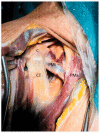Pectoralis minor syndrome: diagnosis with Botulinum injection and treatment with tenotomy - a prospective case series
- PMID: 35265181
- PMCID: PMC8899325
- DOI: 10.1177/1758573220968454
Pectoralis minor syndrome: diagnosis with Botulinum injection and treatment with tenotomy - a prospective case series
Abstract
Background: Pectoralis minor syndrome involves pain, paraesthesia and weakness in the arm due to compression of the brachial plexus passing beneath pectoralis minor; this paper reports the results of a single centre's treatment pathway in affected patients.
Methods: During a four-year period, patients exhibiting symptoms of pectoralis minor syndrome without significant improvement following physiotherapy proceeded to Botulinum injection. Those with good response to injection but subsequent recurrence of symptoms were offered pectoralis minor tenotomy. Oxford shoulder Scores were collected at baseline and after interventions.
Results: Twenty-one patients received Botulinum injection; at six weeks following injection, mean change in Oxford Shoulder Score was +12.4, with only one patient reporting a worsening of symptoms. Of the 17 patients with clinically significant response to injection, 12 have subsequently undergone tenotomy; three months following tenotomy, mean change in Oxford Shoulder Score from baseline was +22.3. Improvement was maintained in all patients at prolonged follow-up (average 20 months post-tenotomy).
Discussion: This pathway has shown to be extremely effective in patients not responding to first-line treatment for pectoralis minor syndrome, with 85% of patients post-injection and 100% of patients post-tenotomy showing significant (greater than published minimal clinically important difference value of six points) improvements in Oxford Shoulder Score, maintained at follow-up.
Keywords: Botulinum injection; Pectoralis minor syndrome; shoulder surgery; tenotomy.
© 2020 The British Elbow & Shoulder Society.
Conflict of interest statement
Declaration of Conflicting Interests: The author(s) declared no potential conflicts of interest with respect to the research, authorship, and/or publication of this article.
Figures



Similar articles
-
Recurrent neurogenic thoracic outlet syndrome stressing the importance of pectoralis minor syndrome.Vasc Endovascular Surg. 2011 Jan;45(1):33-8. doi: 10.1177/1538574410388311. Vasc Endovascular Surg. 2011. PMID: 21193463
-
Arthroscopic release of the pectoralis minor tendon as an adjunct to acromioplasty in the treatment of subacromial syndrome associated with scapular dyskinesia.Orthop Traumatol Surg Res. 2022 Apr;108(2):103211. doi: 10.1016/j.otsr.2022.103211. Epub 2022 Jan 22. Orthop Traumatol Surg Res. 2022. PMID: 35077896
-
Early effectiveness of isolated pectoralis minor tenotomy in selected patients with neurogenic thoracic outlet syndrome.J Vasc Surg. 2013 May;57(5):1345-52. doi: 10.1016/j.jvs.2012.11.045. Epub 2013 Feb 1. J Vasc Surg. 2013. PMID: 23375605
-
Pectoralis minor syndrome.Turk J Phys Med Rehabil. 2022 Nov 22;68(4):447-455. doi: 10.5606/tftrd.2023.12037. eCollection 2022 Dec. Turk J Phys Med Rehabil. 2022. PMID: 36589355 Free PMC article. Review.
-
[Pectoralis major muscle transfer for reconstruction of elbow flexion in posttraumatic brachial plexus lesions].Oper Orthop Traumatol. 2009 Jun;21(2):126-40. doi: 10.1007/s00064-009-1701-z. Oper Orthop Traumatol. 2009. PMID: 19685223 Review. German.
Cited by
-
Ideal Injection Points for Botulinum Neurotoxin for Pectoralis Minor Syndrome: A Cadaveric Study.Toxins (Basel). 2023 Oct 7;15(10):603. doi: 10.3390/toxins15100603. Toxins (Basel). 2023. PMID: 37888634 Free PMC article.
-
An Uncommon Culprit: Trapezius Dystonia as a Cause of Thoracic Outlet Syndrome: A Case Report.Cureus. 2024 Jul 4;16(7):e63825. doi: 10.7759/cureus.63825. eCollection 2024 Jul. Cureus. 2024. PMID: 39099970 Free PMC article.
-
The Elias University Hospital Approach: A Visual Guide to Ultrasound-Guided Botulinum Toxin Injection in Spasticity: Part II-Proximal Upper Limb Muscles.Toxins (Basel). 2025 May 31;17(6):276. doi: 10.3390/toxins17060276. Toxins (Basel). 2025. PMID: 40559854 Free PMC article. Review.
References
-
- Vemuri C, Wittenberg AM, Caputo FJ, et al. Early effectiveness of isolated pectoralis minor tenotomy in selected patients with neurogenic thoracic outlet syndrome. J Vasc Surg 2013; 57: 1345–1352. - PubMed
-
- Sanders RJ, Annest SJ. Thoracic outlet and pectoralis minor syndromes. Semin Vasc Surg 2014; 27: 86–117. - PubMed
-
- Sanders RJ, Rao NM. The forgotten pectoralis minor syndrome: 100 operations for pectoralis minor syndrome alone or accompanied by neurogenic thoracic outlet syndrome. Ann Vasc Surg 2010; 24: 701–708. - PubMed
-
- Torriani M, Gupta R, Donahue DM. Botulinum toxin injection in neurogenic thoracic outlet syndrome: results and experience using a ultrasound-guided approach. Skeletal Radiol 2010; 39: 973–980. - PubMed
LinkOut - more resources
Full Text Sources
